Sierra Wireless MC8775-H Multi-Mode & Multi-Band Wireless Network MiniCard User Manual Notebook
Sierra Wireless Inc. Multi-Mode & Multi-Band Wireless Network MiniCard Notebook
Contents
Notebook User Manual

Notebook Tour
User Guide
© Copyright 2006 Hewlett-Packard
Development Company, L.P.
Microsoft and Windows are U.S. registered
trademarks of Microsoft Corporation.
Bluetooth is a trademark owned by its
proprietor and used by Hewlett-Packard
Company under license. SD Logo is a
trademark of its proprietor. Java is a U.S.
trademark of Sun Microsystems, Inc.
The information contained herein is subject
to change without notice. The only
warranties for HP products and services are
set forth in the express warranty statements
accompanying such products and services.
Nothing herein should be construed as
constituting an additional warranty. HP shall
not be liable for technical or editorial errors
or omissions contained herein.
First Edition: May 2006
Document Part Number: 406756-001
Table of contents
1 Components
Top components ................................................................................................................................... 2
Pointing Devices .................................................................................................................. 2
TouchPad ............................................................................................................................ 3
Lights ................................................................................................................................... 4
Buttons, switches, and readers ............................................................................................ 6
Keys ..................................................................................................................................... 7
Hotkey quick reference ........................................................................................................ 7
Front components ................................................................................................................................ 9
Rear components ............................................................................................................................... 10
Right-side components ....................................................................................................................... 11
Left-side components ......................................................................................................................... 12
Bottom components ........................................................................................................................... 13
Display components ........................................................................................................................... 15
WLAN antennae ................................................................................................................................. 16
WWAN antenna ................................................................................................................................. 17
Additional hardware components ....................................................................................................... 18
Labels ................................................................................................................................................. 19
2 Specifications
Operating environment ....................................................................................................................... 21
Rated input power .............................................................................................................................. 22
Index ................................................................................................................................................................... 23
ENWW iii
iv ENWW

1 Components
This chapter explains the hardware features of the computer.
To see a list of hardware installed in the computer:
1. Select Start > My Computer.
2. In the left pane of the System Tasks window, select View system information.
3. Select Hardware tab > Device Manager.
You can also add hardware or modify device configurations using Device Manager.
NOTE Components included with the computer may vary by region and by model. The
illustrations in this chapter identify the standard features included in most computer models.
ENWW 1
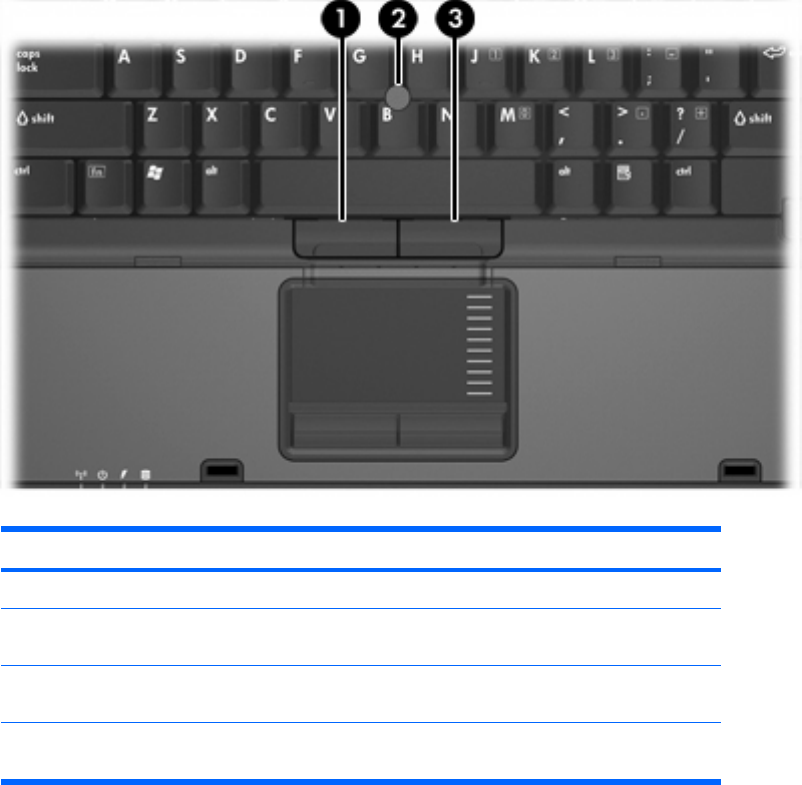
Top components
Pointing Devices
Component Description
(1) Left pointing stick button Functions like the left button on an external mouse.
(2) Pointing stick Moves the pointer and selects or activates items on
the screen.
(3) Right pointing stick button Functions like the right button on an external
mouse.
*This table describes factory settings. To view and change pointing device preferences, select Start
> Control Panel > Printers and Other Hardware > Mouse.
2 Chapter 1 Components ENWW
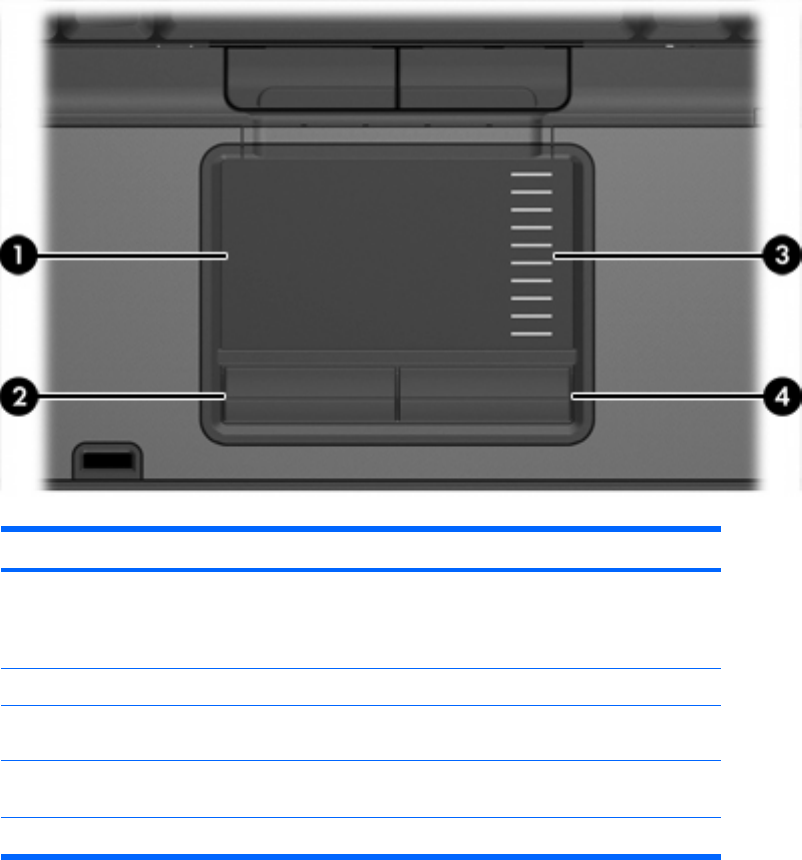
TouchPad
Component Description
(1) TouchPad* Moves the pointer and selects or activates items on
the screen. Can be set to perform other mouse
functions, such as scrolling, selecting, and double-
clicking
(2) Left TouchPad button* Functions like the left button on an external mouse.
(3) TouchPad scroll zone Scrolls up or down.
(4) Right TouchPad button* Functions like the right button on an external
mouse.
*This table describes factory settings.
ENWW Top components 3
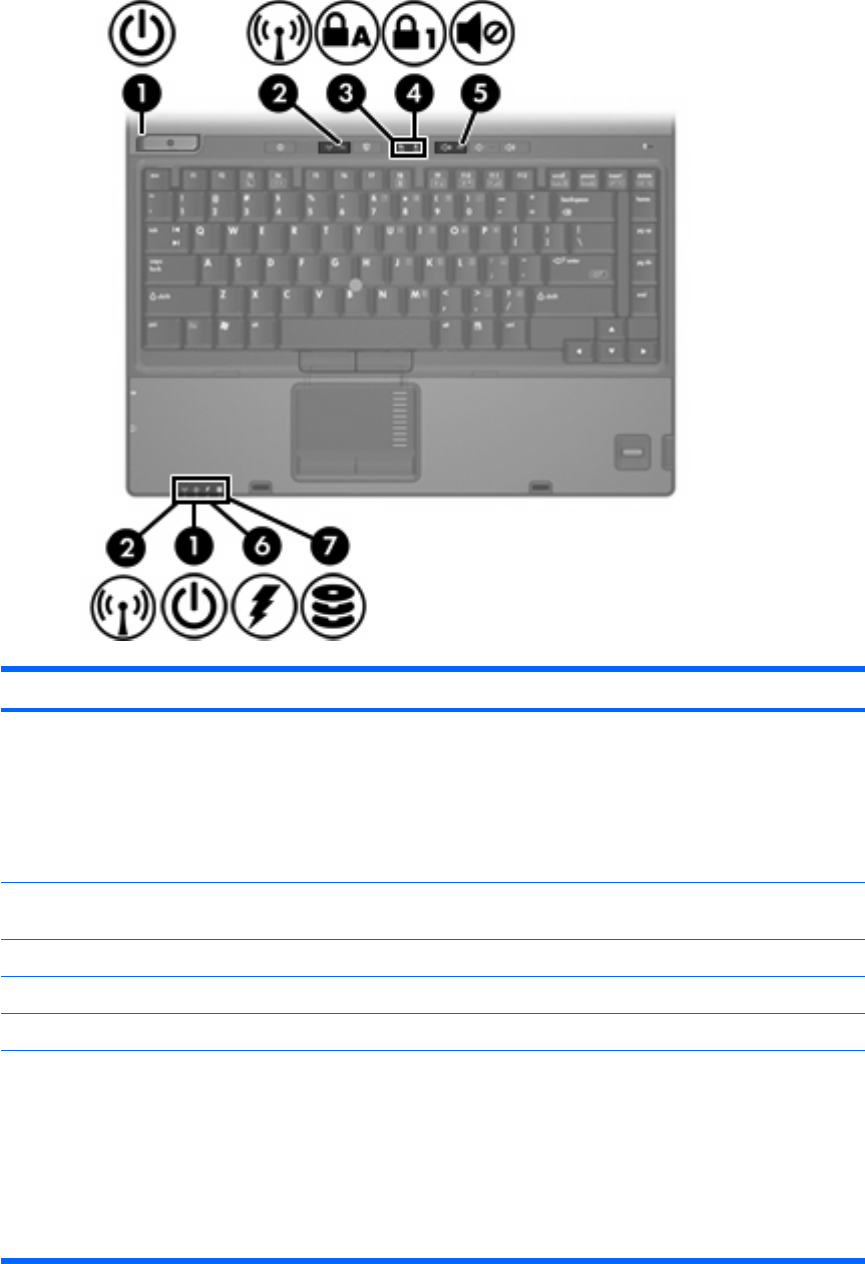
Lights
Component Description
(1) Power lights * (2) On: The computer is on.
Blinking: The computer is in standby.
Blinking rapidly: An AC adapter with a higher power rating should be
connected.
Off: The computer is off or in hibernation.
(2) Wireless lights† (2) On: An integrated wireless device, such as a wireless local area network (LAN)
device and/or a Bluetooth® device, is turned on.
(3) Caps lock light On: Caps lock is on.
(4) Num lock light On: Num lock is on or the embedded numeric keypad is enabled.
(5) Volume mute light On: Computer sound is turned off.
(6) Battery light Amber: A battery is charging.
Green: A battery is close to full charge capacity.
Blinking amber: A battery that is the only available power source has reached
a low-battery condition. When the battery reaches a critical low-battery
condition, the battery light begins blinking rapidly.
Off: If the computer is plugged into an external power source, the light is turned
off when all batteries in the computer are fully charged. If the computer is not
4 Chapter 1 Components ENWW

Component Description
plugged into an external power source, the light stays off until the battery
reaches a low-battery condition.
(7) Drive light ●Blinking: The hard drive or optical drive is being accessed.
●Amber: HP Mobile Data Protection has temporarily parked the internal
hard drive.
*There are 2 power lights. Both display the same information. The light on the power button is visible only when the
computer is open; the other power light is always visible on the front of the computer.
†There are 2 wireless lights. Both display the same information. The light on the wireless button is visible only when the
computer is open; the other wireless light is always visible on the front of the computer.
ENWW Top components 5
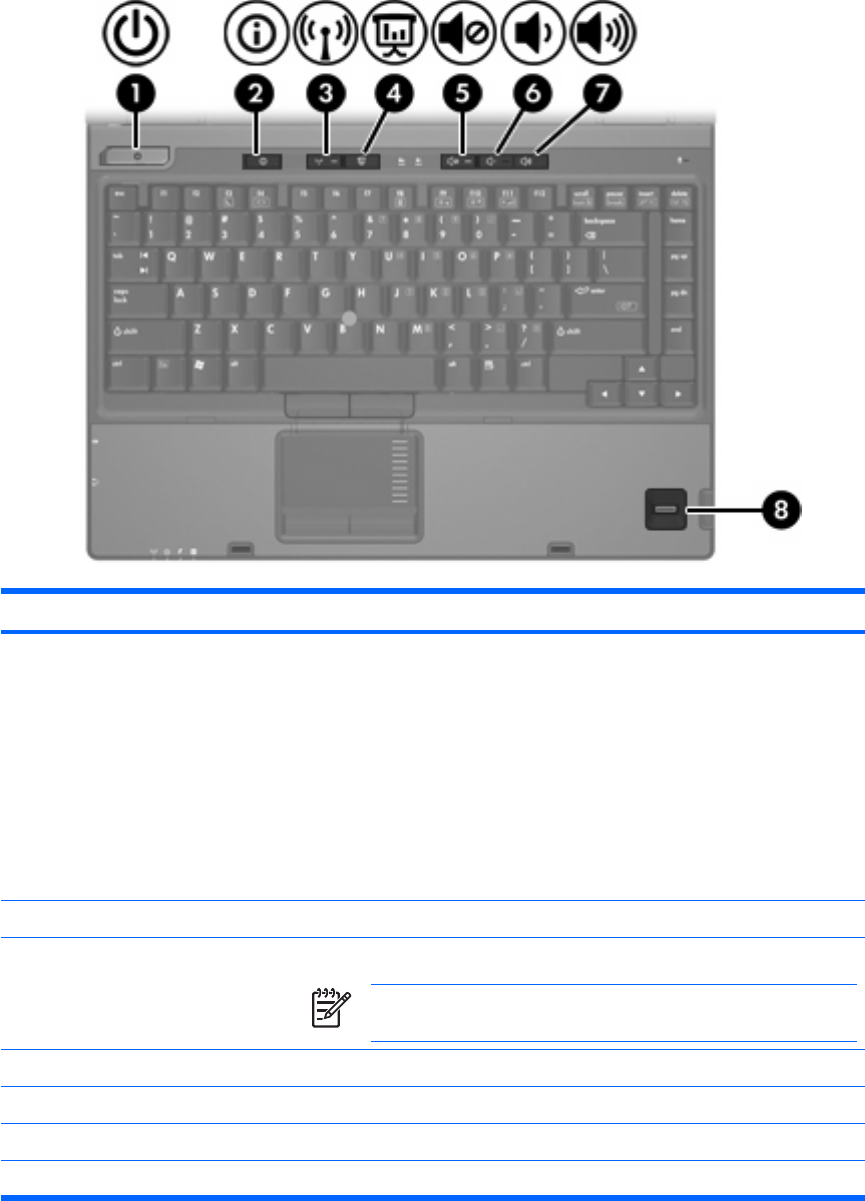
Buttons, switches, and readers
Component Description
(1) Power button* When the computer is
●Off, press to turn on the computer.
●On, press to enter hibernation.
●In standby, briefly press to exit standby.
●In hibernation, briefly press to exit hibernation.
If the computer has stopped responding and Microsoft® Windows® shutdown
procedures cannot be used, press and hold the power button for at least 5
seconds to turn off the computer.
(2) Info Center button Launches Info Center, which enables you to open various software solutions.
(3) Wireless button* Turns the wireless feature on or off, but does not create a wireless connection.
NOTE To establish a wireless connection, a wireless network must
already be set up.
(4) Presentation button Starts the Presentation feature.
(5) Volume mute button Mutes and restores computer sound.
(6) Volume down button Decreases speaker volume.
(7) Volume up button Increases speaker volume
6 Chapter 1 Components ENWW
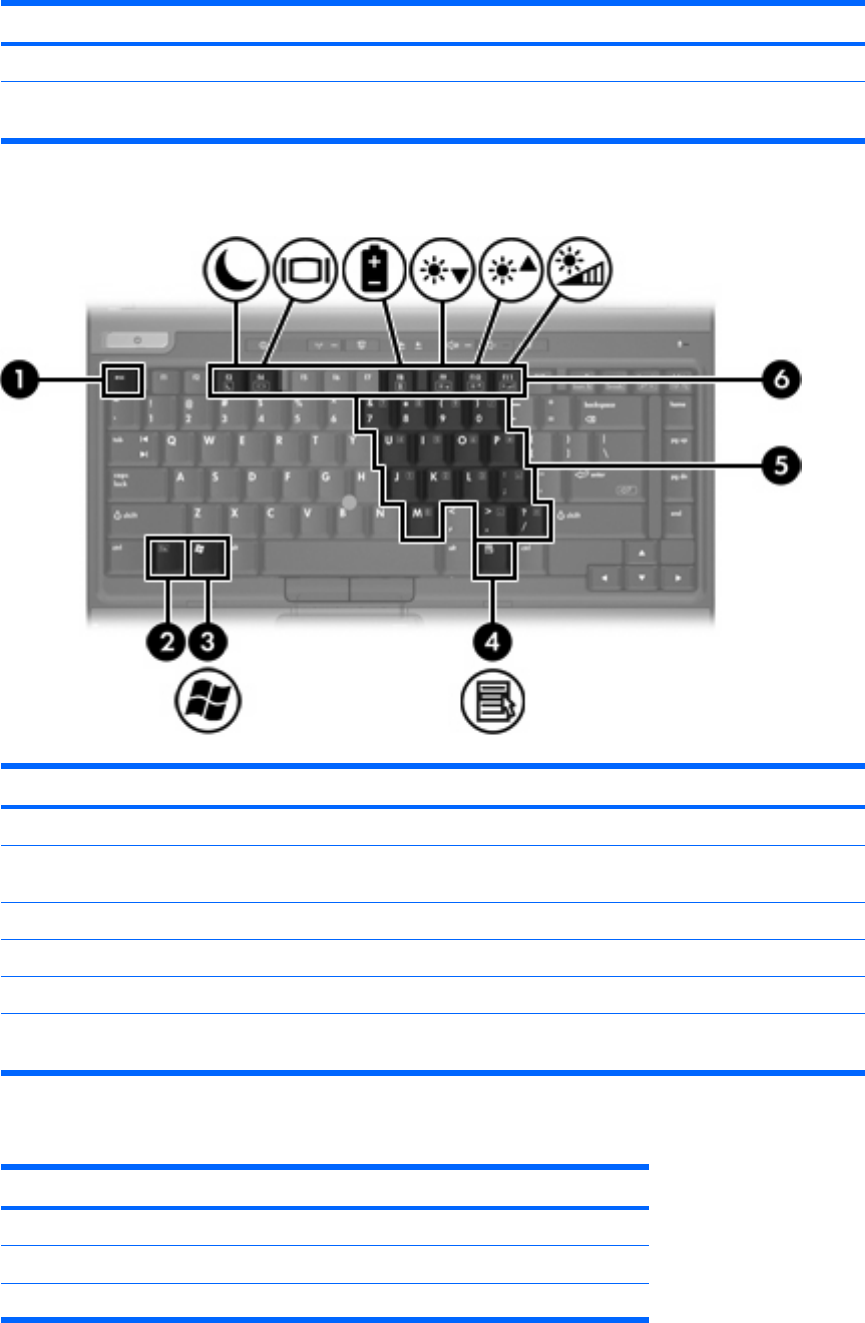
Component Description
(8) Fingerprint reader Allows a fingerprint logon to Windows, instead of a password logon.
*This table describes factory settings. For information about changing factory settings, refer to the user guides located in
the Help and Support Center.
Keys
Component Description
(1) esc key Displays system information when pressed in combination with the fn key.
(2) fn key Executes frequently used system functions when pressed in combination with
a function key or the esc key.
(3) Windows logo key Displays the Microsoft Windows Start menu.
(4) Windows applications key Displays a shortcut menu for items beneath the pointer.
(5) Embedded numeric keypad keys Can be used like the keys on an external numeric keypad.
(6) Function keys Execute frequently used system functions when pressed in combination with
the fn key.
Hotkey quick reference
Function Key Combination
Display system information fn+esc
Clear system information fn+esc or click OK
Initiate standby fn+f3
ENWW Top components 7

Function Key Combination
Alternate image between the computer display and external
display
fn+f4
Display battery information fn+f8
Clear battery information fn+f8
Decrease screen brightness fn+f9
Increase screen brightness fn+f10
Turn on and off the ambient light sensor fn+f11
8 Chapter 1 Components ENWW
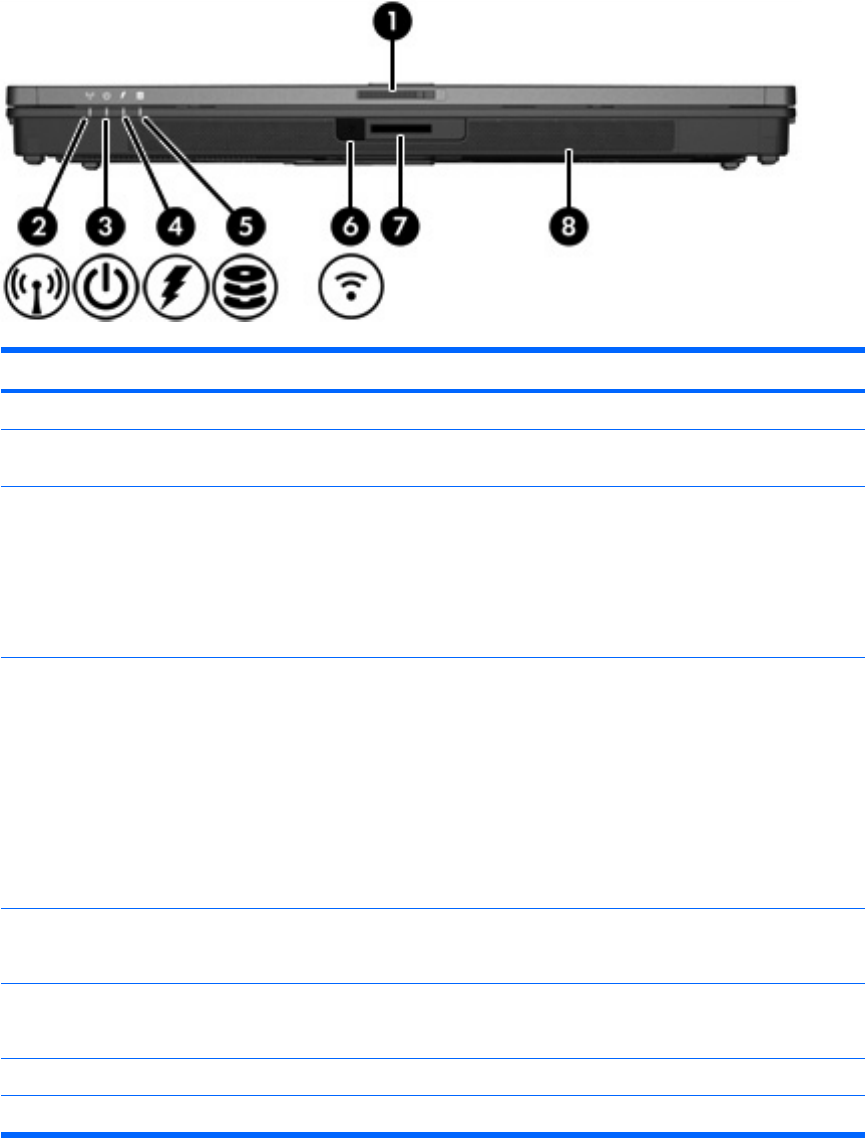
Front components
Component Description
(1) Display release latch Opens the computer.
(2) Wireless light On: An integrated wireless device, such as a wireless local area network (LAN)
device and/or a Bluetooth® device is turned on.
(3) Power light On: The computer is on.
Blinking: The computer is in standby.
Blinking rapidly: An AC adapter with a higher power rating should be
connected.
Off: The computer is off or in hibernation.
(4) Battery light Amber: A battery is charging.
Green: A battery is close to full charge capacity.
Blinking amber: A battery that is the only available power source has reached
a low-battery condition. When the battery reaches a critical low-battery
condition, the battery light begins blinking rapidly.
Off: If the computer is plugged into an external power source, the light is turned
off when all batteries in the computer are fully charged. If the computer is not
plugged into an external power source, the light stays off until the battery
reaches a low-battery condition.
(5) Drive light ●Blinking: The hard drive or optical drive is being accessed.
●Amber: HP Mobile Data Protection has temporarily parked the hard drive.
(6) Infrared port Provides wireless communication between the computer and an optional IrDA-
compliant device.
(7) Digital Media Slot Supports SD (Secure Digital) Memory Cards.
(8) Speakers Produce computer sound.
ENWW Front components 9
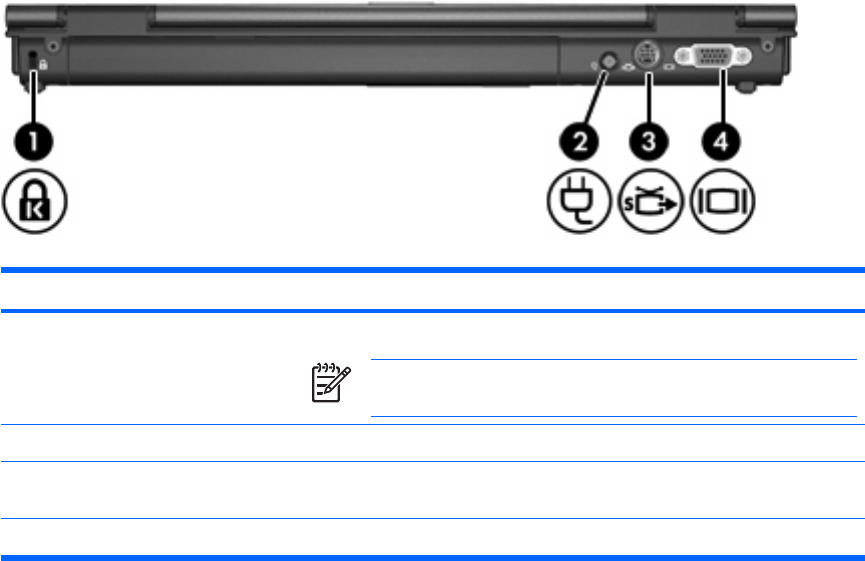
Rear components
Component Description
(1) Security cable slot Attaches an optional security cable to the computer.
NOTE The security cable is designed to act as a deterrent, but may
not prevent the computer from being mishandled or stolen.
(2) Power connector Connects an AC adapter.
(3) S-Video-out jack Connects an optional S-Video device such as a television, VCR, camcorder,
overhead projector, or video capture card.
(4) External monitor port Connects an external VGA monitor or projector.
10 Chapter 1 Components ENWW
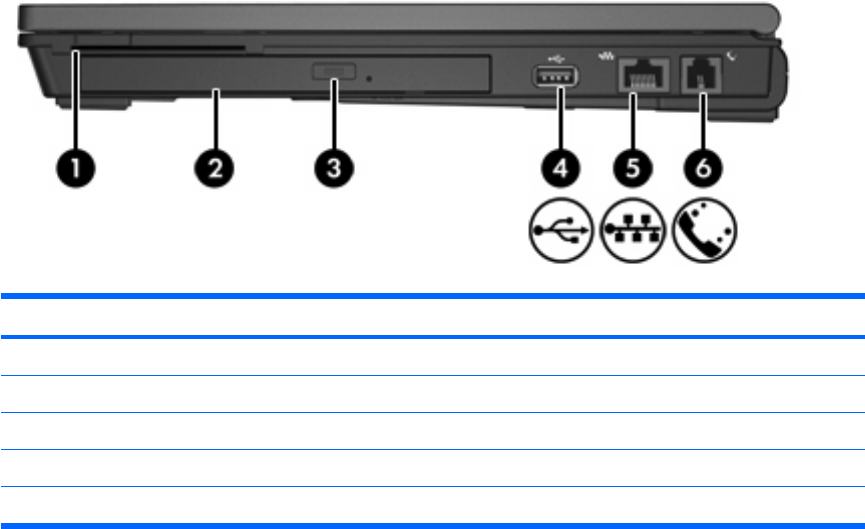
Right-side components
Component Description
(1) Smart card reader Supports smart cards and Java™ Cards.
(2) MultiBay optical drive Reads an optical disc.
(3) USB port Connects an optional USB device.
(4) RJ-45 (network) jack Connects a network cable.
(5) RJ-11 (modem) jack Connects a modem cable.
ENWW Right-side components 11
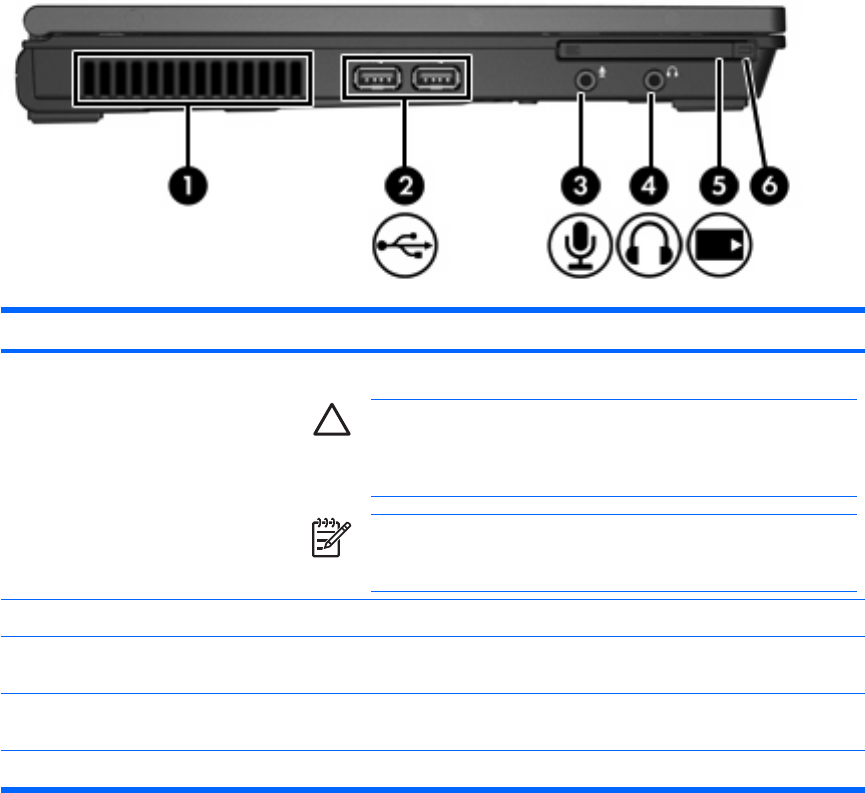
Left-side components
Component Description
(1) Vent Enables airflow to cool internal components.
CAUTION To prevent overheating, do not obstruct vents. Use the
computer only on a hard, flat surface. Do not allow another hard
surface, such as an adjoining optional printer, or a soft surface, such
as pillows or thick rugs or clothing, to block airflow.
NOTE The computer fan starts up automatically to cool internal
components and prevent overheating. It is normal for the internal fan
to cycle on and off during routine operation.
(2) USB ports (2) Connects an optional USB device.
(3) Audio-in (microphone) jack Connects an optional computer headset microphone, stereo array microphone,
or monoaural microphone.
(4) Audio-out (headphone) jack Produces computer sound when connected to optional powered stereo
speakers, headphones, ear buds, a headset, or television audio.
(5) PC Card slot Supports optional Type I or Type II 32-bit (CardBus) or 16-bit PC Cards.
12 Chapter 1 Components ENWW
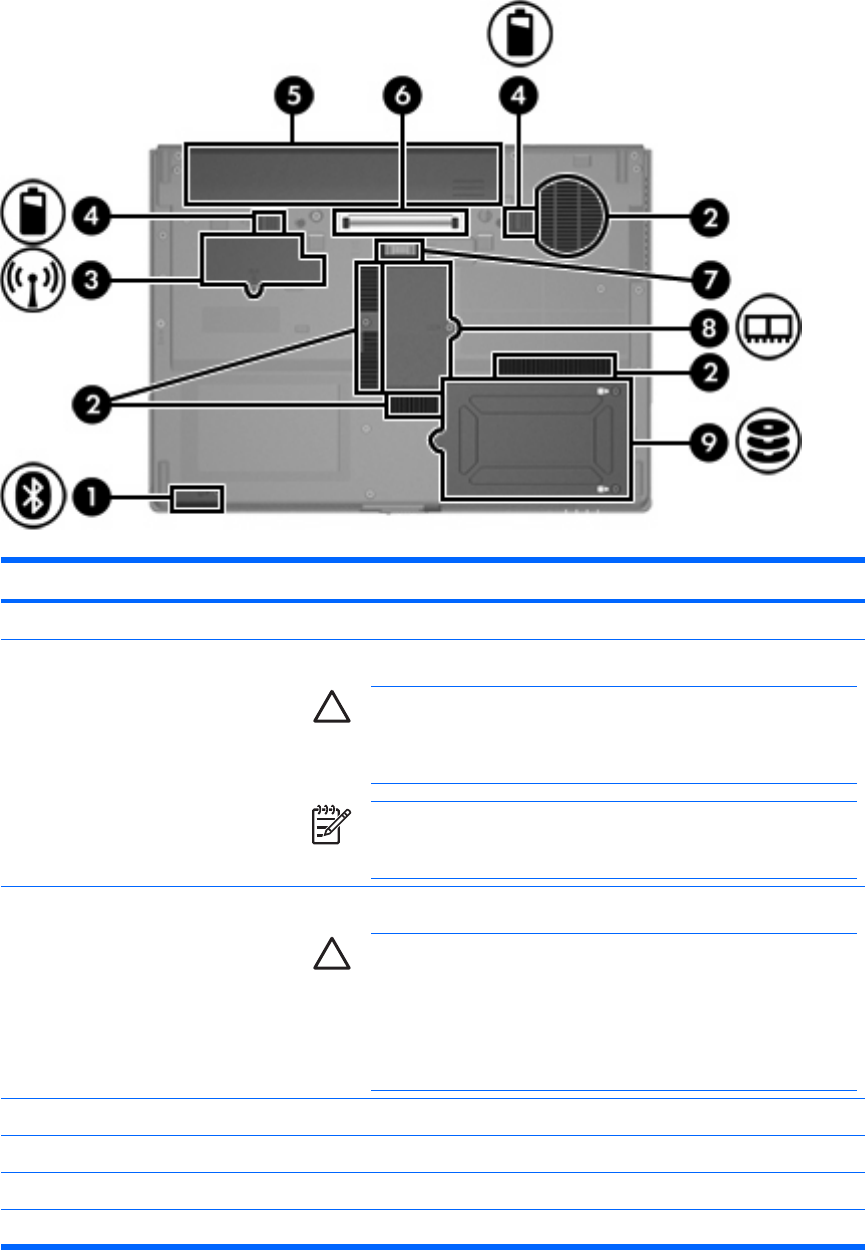
Bottom components
Component Description
(1) Bluetooth compartment Contains a Bluetooth device (select models only).
(2) Vents (4) Enable airflow to cool internal components.
CAUTION To prevent overheating, do not obstruct vents. Use the
computer only on a hard, flat surface. Do not allow another hard
surface, such as an adjoining optional printer, or a soft surface, such
as pillows or thick rugs or clothing, to block airflow.
NOTE The computer fan starts up automatically to cool internal
components and prevent overheating. It is normal for the internal fan
to cycle on and off during routine operation.
(3) Mini Card compartment Contains a wireless LAN device (select models only)
CAUTION To prevent an unresponsive system and the display of a
warning message, replace the devices with only a Mini Card
authorized for use in the computer by the governmental agency that
regulates wireless devices in your country, If you replace the device
and then receive a warning message, remove the device to restore
computer functionality, and then contact Customer Care through the
Help and Support Center.
(4) Battery release latches Release the battery from the battery bay.
(5) Battery bay Holds the battery.
(6) Docking connector Connects an optional docking device.
(7) Accessory battery connector Connects an optional accessory battery.
ENWW Bottom components 13

Component Description
(8) Memory module compartment Contains the memory module slot.
(9) Hard drive bay Holds the hard drive.
14 Chapter 1 Components ENWW
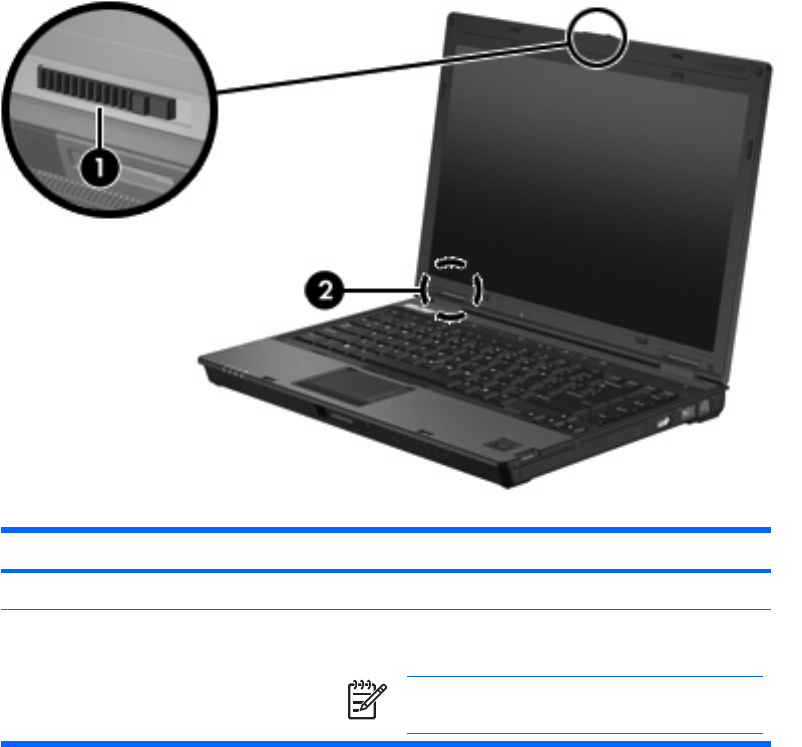
Display components
Component Description
(1) Display release latch Opens the computer.
(2) Internal display switch Turns off the display if the display is closed while the
computer is turned on.
NOTE This switch is not visible from the outside
of the computer.
ENWW Display components 15
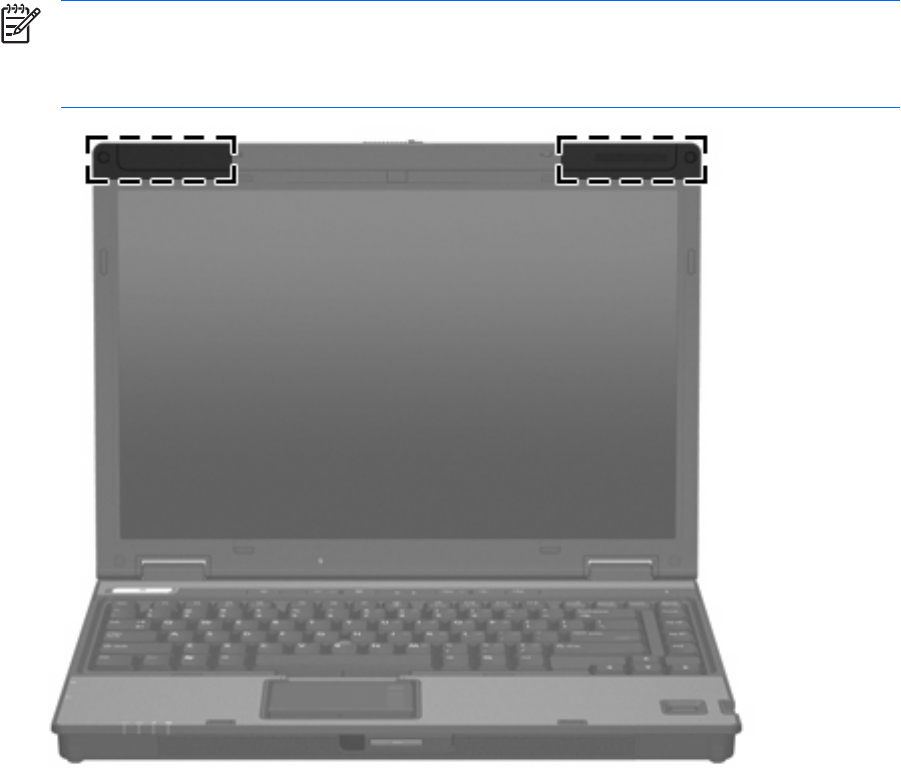
WLAN antennae
Two wireless antennae send and receive wireless device signals over wireless local area networks
(WLANs). These antennae are not visible from the outside of the computer.
For wireless regulatory notices pertaining to your region, refer to the Regulatory, Safety, and
Environmental Notices located in the Help and Support Center.
NOTE For optimal transmission, keep the areas immediately around the antennae free from
obstructions.
NOTE The computer display must be open before you can connect to a wireless network.
16 Chapter 1 Components ENWW
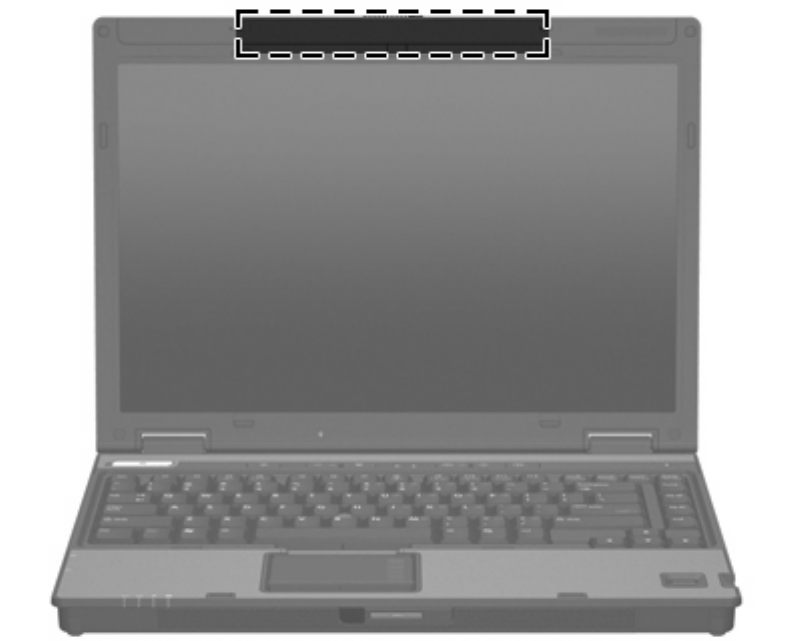
WWAN antenna
The wireless antenna inside the display enclosure allows you to connect to a wireless wide-area network
(WWAN), and then to the Internet, using the integrated HP Broadband Wireless module and service
from a supported cellular network operator.
For more information on HP Broadband Wireless and how to sign up for service, refer to the HP
Broadband Wireless Getting Started guide included with your computer.
ENWW WWAN antenna 17
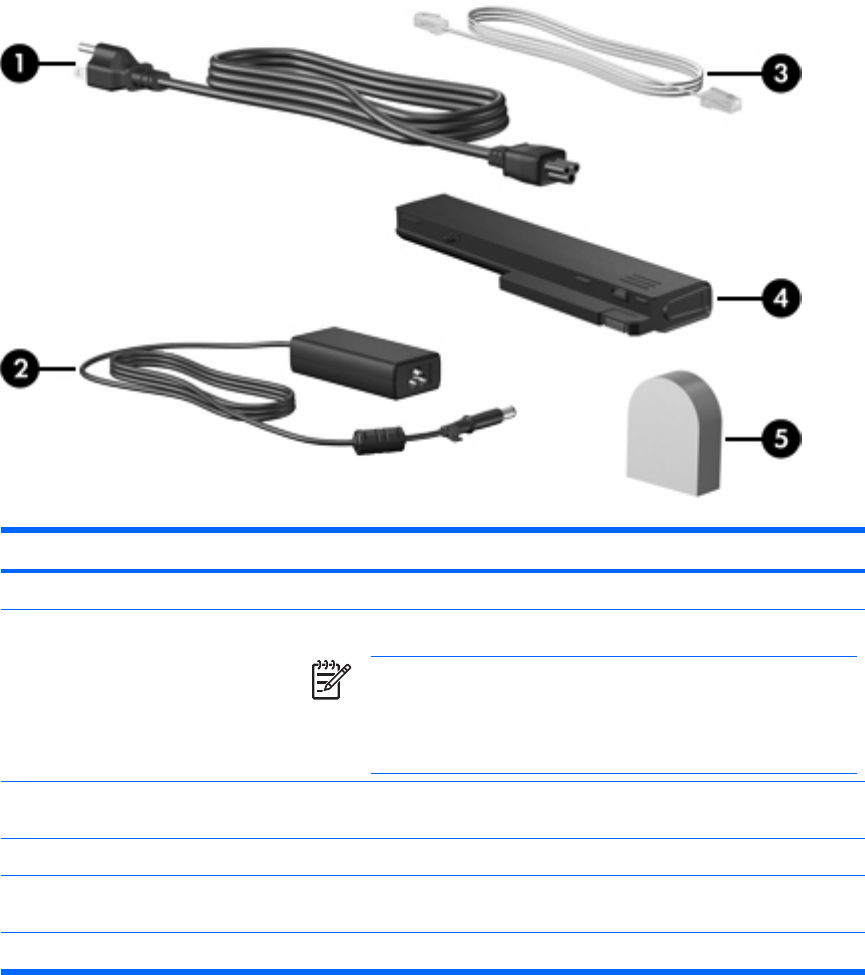
Additional hardware components
Component Description
(1) Power cord* Connects an AC adapter to an AC outlet.
(2) HP Smart AC Adapter Converts AC power to DC power.
NOTE The computer operates on DC power, which can be supplied
by an AC or a DC power source. Although the computer can be
powered from a stand alone DC power source, it should be powered
only with an AC adapter or a DC power source supplied and approved
by HP for use with the computer.
(3) Modem cable* Connects the internal modem to an RJ-11 telephone jack or to a country-
specific modem adapter.
(4) Battery* Powers the computer when the computer is not plugged into external power.
(5) Country-specific modem cable
adapter (select models only)
Adapts the modem cable to a non-RJ-11 telephone jack.
*Modem cables, batteries, and power cords vary in appearance by region and country.
18 Chapter 1 Components ENWW
Labels
The labels affixed to the computer provide information you may need when you troubleshoot system
problems or travel internationally with the computer.
●Service tag—Provides the product brand and series name, serial number (s/n), and product
number (p/n) of your computer. Have this information available when you contact Customer Care.
The service tag label is affixed to the bottom of the computer.
●Microsoft Certificate of Authenticity—Contains the Microsoft® Windows® Product Key. You may
need the Product Key to update or troubleshoot the operating system. This certificate is affixed to
the bottom of the computer.
●Regulatory label—Provides regulatory information about the computer. The regulatory label is
affixed to the bottom of the computer.
●Modem approval label—Provides regulatory information about the modem and lists the agency
approval markings required by some of the countries in which the modem has been approved for
use. You may need this information when traveling internationally. The modem approval label is
affixed to the bottom of the computer.
●Wireless certification label(s)—Provide information about optional wireless devices available on
select models, and the approval markings of some of the countries in which the devices have been
approved for use. An optional device may be a wireless local area network (WLAN) device or an
optional Bluetooth® device. If your computer model includes one or more wireless devices, one or
more certification labels are included with your computer. You may need this information when
traveling internationally. Wireless certification labels are affixed to the bottom of the computer.
ENWW Labels 19
20 Chapter 1 Components ENWW

2 Specifications
Operating environment
The operating environment information in the following table may be helpful if you plan to use or transport
the computer in extreme environments.
Factor Metric U.S.
Temperature
Operating (not writing to optical disc) 0˚C to 35˚C32˚F to 95˚F
Operating (writing to optical disc) 5˚C to 35˚C41˚F to 95˚F
Nonoperating -20˚C to 60˚C-4˚F to 140˚F
Relative humidity (noncondensing)
Operating 10% to 90% 10% to 90%
Nonoperating 5% to 95% 5% to 95%
Maximum altitude (unpressurized)
Operating (14.7 to 10.1 psia*) -15 m to 3,048 m -50 ft to 10,000 ft
Nonoperating (14.7 to 4.4 psia*) -15 m to 12,192 m -50 ft to 40,000 ft
*Pounds per square inch absolute (psia) is another unit of measurement for altitude.
ENWW Operating environment 21

Rated input power
The power information in this section may be helpful if you plan to travel internationally with your
computer.
The computer operates on DC power, which can be supplied by an AC or a DC power source. Although
the computer can be powered from a stand alone DC power source, it should be powered only with an
AC adapter or a DC power source supplied and approved by HP for use with the computer.
The computer is capable of accepting DC power within the following specifications.
Input power Rating
Operating voltage 18.5 V dc @ 3.5 A – 65 W; 19.0 V dc @
4.74 A – 90W
Operating current 3.5 A; or 4.9 A
This product is designed for IT power systems in Norway with phase-to-phase voltage not exceeding
240 V rms.
22 Chapter 2 Specifications ENWW
Index
A
AC adapter
identifying 18
altitude specifications 21
antennae 16
applications key, Windows 7
audio-in (microphone) jack 12
audio-out (headphone) jack 12
B
battery
identifying 18
battery bay 13, 19
battery charge information 8
battery light, identifying 4, 9
battery release latch 13
bays
battery 13, 19
Bluetooth device 13
hard drive 14
Bluetooth compartment 13
Bluetooth label 19
buttons
mute 6
power 6
wireless 6
C
cable
RJ-11 (modem) 18
caps lock light 4
Certificate of Authenticity label 19
compartments
Bluetooth 13
memory module 14
Mini Card 13
components
bottom 13
display 15
front 9
left-side 12
rear 10
right-side 11
top 2
connector, power 10
cord, power, identifying 18
D
display
image, switching 8
screen brightness hotkeys 8
display release latch 9, 15
display switch 15
docking connector 13
drive light 5, 9
drives
hard 14
optical 11
E
environmental specifications 21
external monitor port 10
F
fingerprint reader 7
fn key
identifying 7
function keys
identifying 7
H
hard drive bay, identifying 14
headphone (audio-out) jack 12
hotkeys
battery charge information 8
decreasing screen brightness
8
displaying system information
7
increasing screen brightness
8
initiating standby 7
setting ambient light sensor 8
switching screen image 8
humidity specifications 21
I
Info Center button 6
internal display switch 15
J
jacks
audio-in (microphone) 12
audio-out (headphone) 12
RJ-11 (modem) 11
RJ-45 (network) 11
K
keypad keys 7
keys
esc 7
fn 7
function 7
keypad 7
Windows applications 7
Windows logo 7
L
labels
Bluetooth 19
Microsoft Certificate of
Authenticity 19
modem approval 19
regulatory 19
service tag 19
wireless certification 19
WLAN 19
latches
battery release 13
ENWW Index 23
display release 9, 15
lights
battery 4, 9
caps lock 4
drive 5, 9
mute 4
num lock 4
power 4, 9
volume 4
wireless 4, 9
lock, security cable 10
M
memory module compartment 14
microphone (audio-in) jack 12
Microsoft Certificate of Authenticity
label 19
Mini Card compartment 13
modem approval label 19
modem cable adapter 18
monitor port, external 10
mute button 6
mute light 4
N
network (RJ-45) jack 11
num lock light 4
O
operating environment
specifications 21
operating system
Microsoft Certificate of
Authenticity label 19
Product Key 19
optical drive, identifying 11
P
PC Card slot 12
ports
external monitor 10
USB 11, 12
power button 6
power connector 10
power cord 18
power light 4, 9
Presentation button 6
Product Key 19
product name and number,
computer 19
R
rated input power specifications
22
reader, fingerprint 7
regulatory information
modem approval label 19
regulatory label 19
wireless certification labels 19
release latch
battery 13
display 9
RJ-11 (modem) cable 18
RJ-11 (modem) jack 11
RJ-45 (network) jack 11
S
screen brightness hotkeys 8
screen image, switching 8
security cable slot 10
serial number, computer 19
service tag 19
slots
memory module 14
PC Card 12
security cable 10
smart card reader 11
speakers 9
specifications
operating environment 21
rated input power 22
standby
hotkey 7
system information
hotkey 7
T
temperature specifications 21
traveling with the computer
environmental specifications
22
modem approval label 19
wireless certification labels 19
U
USB ports, identifying 11, 12
V
vents 12, 13
W
Windows applications key 7
Windows logo key 7
wireless antennae 16
wireless button 6
wireless certification label 19
wireless light 4, 9
WLAN device 19
WLAN label 19
WWAN device 17
24 Index ENWW
